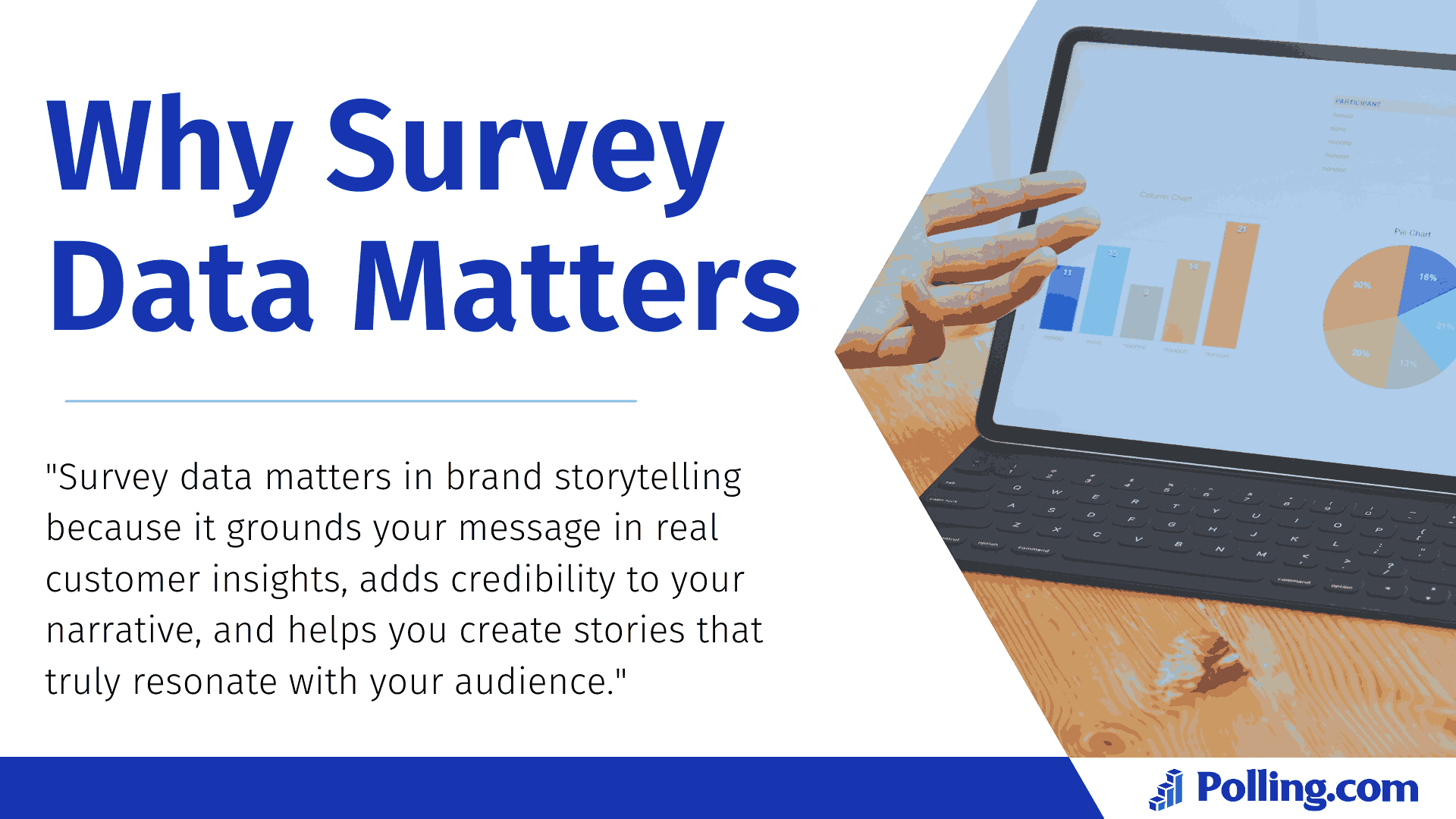
Why Survey Data Matters for Strong Brand Storytelling
In today’s competitive world of content and advertising, survey data is one of the most powerful tools brands can use to build real, emotional connections with their audience. Have you ever wondered why some brand stories feel more believable and engaging than others? It’s usually because they are backed by real insights not just assumptions. This is where branded surveys come in.
Branded surveys give companies a chance to understand their audience, reflect their identity, and use real-world answers to guide their storytelling. And it’s not just about asking questions. With platforms like Polling.com, brands can design smart, strategic surveys that do more than collect feedback. They tell a story, build trust, and even drive marketing results.
Let’s explore why this kind of client survey software isn’t just helpful it’s necessary in the modern marketing world.
What Are Branded Surveys and Why Are They Effective?
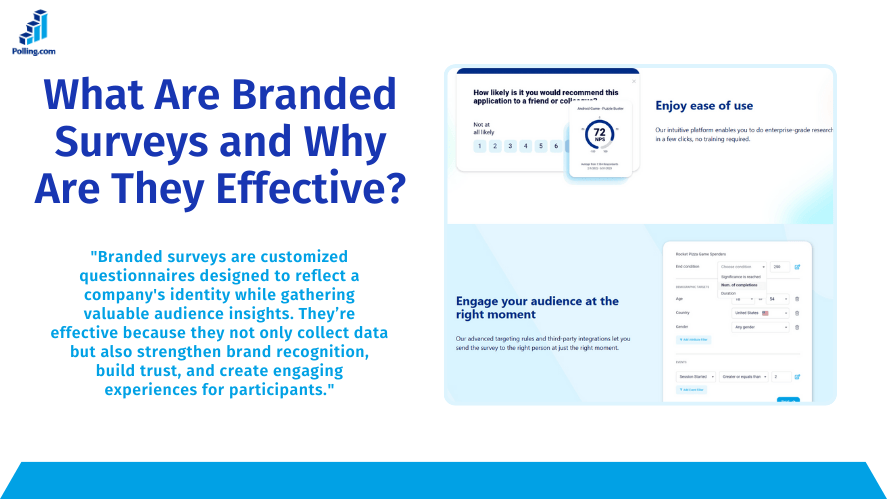
Branded surveys are more than just forms with your logo on top. They’re a blend of smart design, thoughtful question types for surveys, and a clear purpose that reflects your brand.
Definition and Core Characteristics
Branded surveys are custom surveys built by brands. They include specific branding elements like logos, colors, and language. But more importantly, they align with the tone and message a company wants to share.
Here’s what sets them apart:
- The design reflects the company’s brand identity.
- The tone and language speak directly to the target audience.
- The questions are tailored to get insights that actually help the business.
Using a branded surveys app, companies can gather data and still keep the audience experience smooth and connected. This kind of survey doesn’t just collect responses. It tells the respondent, “We value your voice and this is who we are.”
Branded vs. Generic Surveys
Let’s compare.
A generic survey might use basic templates, standard fonts, and feel like it’s from a third-party platform. It gets the job done, but it doesn’t leave an impression.
A branded survey, on the other hand:
- Feels like an extension of your website or product.
- Keeps users engaged longer due to familiarity.
- Increases trust in sharing honest opinions.
This is where design and experience really matter. Using platforms like Polling.com, brands can customize everything layout, colors, fonts, and even transitions between questions. This improves the survey process and boosts both completion rates and brand recall.
The Dual Purpose: Data Collection and Brand Awareness
The beauty of branded surveys is that they serve two goals at once:
- Data collection – learning from customers, leads, or even employees.
- Brand touchpoints – reminding people who you are and what you care about.
Let’s say a clothing brand runs a survey asking what styles customers prefer for the next season. Not only do they learn which products to launch, but they also spark curiosity and engagement. People share their answers, maybe even post about it. Now, it’s a story. And it all started with a smart, branded survey.
Even better, when the results are shared publicly, they position the brand as insightful and customer-focused.
Why Survey Data Matters in Brand Storytelling
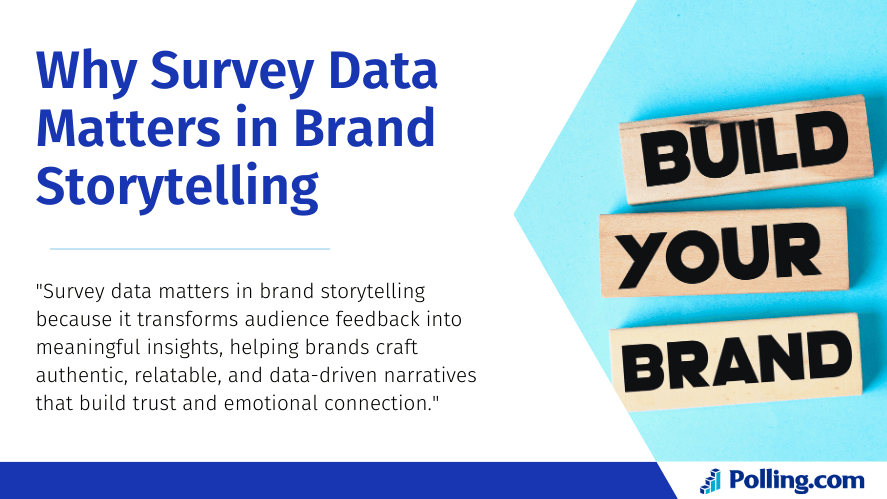
You can’t build a great story without knowing your audience. That’s why survey data is a critical part of any successful brand narrative.
Adds Credibility to Your Message
Think about this. Would you trust a company that says “people love our product” or one that says “87% of users reported improved results within a week”?
Survey and results give weight to your message. They provide proof. Whether you’re pitching a new service or telling your company’s founding story, having data makes the message stronger and more believable.
This is especially important when writing marketing copy, social posts, or PR campaigns. Instead of making guesses, use survey examples with data to support your points. The numbers speak for themselves.
Tells Stories from the Customer’s Point of View
One of the most powerful ways to connect with an audience is to speak their language. With the right brand survey questions, companies can uncover what really matters to their users.
Let’s say you’re launching a new product. By using customer feedback tools like branded surveys, you can ask customers what challenges they face, what features they want, and how they currently solve the problem.
Now your product story isn’t about the produc it’s about the people who need it.
Real quotes from open-ended answers help add emotion. You can also segment your survey responses by persona to build even more targeted campaigns.
Strengthens Thought Leadership and Authority
Publishing original data makes your brand a leader in its field. When you run surveys and share the insights, you’re creating valuable content the kind people link to, cite, and respect.
This is how customer feedback platform strategies can grow beyond internal use. You’re not just listening. You’re speaking up about trends, habits, and insights your competitors don’t have access to.
Do you want to be featured in an industry newsletter or earn backlinks from top blogs? If so, start by sharing your branded survey insights. Additionally, use survey results presentation techniques like infographics, executive summaries, and blog content to make the data easy to share.
Engages Audiences with Interactive Experiences
People love to give their opinions especially when it feels like a two-way conversation. Branded surveys turn a simple interaction into an experience.
Using survey and polling software, you can create engaging, mobile-friendly surveys that:
- Match your tone and design
- Are easy to complete
- Encourage feedback through visual or gamified elements
The result? Higher survey participation rate, stronger engagement, and better data.
Polling.com makes it even easier with real-time analytics, UX-optimized forms, and the ability to connect your survey results to other platforms for deeper storytelling.
How to Create Effective Branded Surveys for Storytelling
Now that we know why survey data is powerful, let’s look at how to build a branded survey that works.
Start with a Clear Narrative Goal
Before you design anything, ask: What story are we trying to tell?
Are you highlighting a shift in your industry? Maybe you’re exploring customer pain points. Or perhaps you’re trying to learn what features people want most.
Your goal should align with your brand’s core message. For example:
- A health brand might ask about daily wellness habits.
- A software brand might focus on digital struggles or productivity gaps.
Polling.com helps brands set goals during the survey creation phase, so every question serves a purpose.
Design for Brand Consistency
People should know it’s your survey just by looking at it. The fonts, colors, and tone should reflect your identity.
A fun, youthful brand might use emojis and conversational language. A corporate brand might stick to professional copy and sleek layouts.
Using a user feedback platform with deep customization (like Polling.com) ensures your surveys aren’t just useful they’re beautiful and on-brand.
This also makes users more likely to trust the survey and complete it, improving your average survey response rate.
Ask the Right Types of Questions
Don’t just ask what’s easy. Ask what matters.
Mix in multiple choice for easy analysis and open-ended questions for rich stories. Use:
- Rating scales (ideal for NPS survey tool tracking)
- Sliders for preferences
- Text boxes for opinions
- Visual choice questions for faster input
This mix allows you to gather both data and quotes, which helps when you’re shaping your story later.
A strong branding questionnaire can include questions like:
- What problem were you trying to solve?
- How did you hear about us?
- How do you feel after using our product?
Keep It Short but Insightful
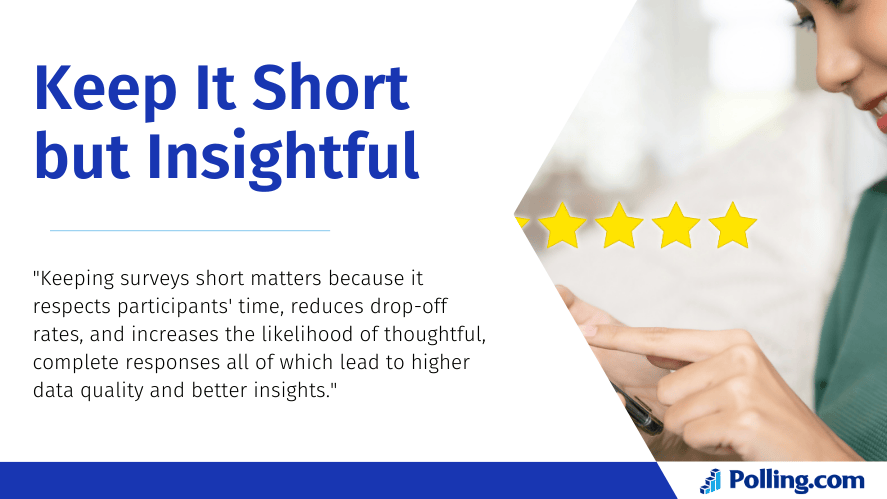
No one wants to fill out a 20-minute survey. Keep it under 10 questions when possible.
The shorter the survey, the higher the response rate. According to research, the typical survey response rate drops sharply after the 5-minute mark.
That’s why Polling.com builds surveys optimized for flow and completion. With clean navigation and smart logic, your audience stays engaged.
Want to increase response rate? Add a progress bar, thank-you message, or even a small reward.
Interpreting Survey Results to Shape Compelling Stories
Collecting survey data is just the beginning. The real value comes from turning it into meaning.
Identify Emotional and Statistical Themes
Once the responses come in, look for:
- Surprising statistics
- Repeating pain points
- Emotional quotes
- High and low points in your ratings
This helps you shape stories that go beyond charts. For example, instead of saying “40% of users had issues logging in,” say, “40% of users told us login struggles were keeping them from using the platform daily.”
Both are true, but the second is a story.
This is what good free business analytics software helps with turning numbers into insights.
Segment Your Audience for Deeper Insights
Not all users are the same. Break down survey responses by:
- Age group
- Job role
- Region
- Loyalty level
You might find that new users care about onboarding, while long-term users want more features. That’s two different stories to tell and two campaigns to run.
Polling.com makes this easy with filters and segmentation tools built into the dashboard.
Create Data Narratives, Not Just Charts
Think of your survey as the source of a short story. Every strong narrative has:
- A problem
- A journey
- A solution
To strengthen your findings, use survey response rate benchmark stats as supporting evidence. Then, combine charts with quotes, testimonials, and commentary to bring the numbers to life and make the story more engaging.
Real-World Examples of Branded Survey Storytelling
Survey data becomes even more powerful when we look at how real brands are using it. Whether it’s creating viral content or building smarter campaigns, these examples show how branded surveys deliver serious value.
Case Study: A Brand Using Polling.com to Drive a Campaign
Let’s imagine a skincare company called GlowNatural launching a new product for sensitive skin. They wanted to create content that spoke directly to their audience’s needs not just guess what people cared about.
Using Polling.com, they created a branded survey that asked users:
- What skin concerns they struggle with
- How many products they try before finding the right one
- What ingredients they avoid
With just 9 questions and strong visual branding, the survey had a survey response percentage of 78%. This was well above the typical survey response rate, thanks to clean design and a clear value for the respondent.
They used the insights to:
- Publish a blog post titled “67% of Women Still Struggle with Redness: Here’s Why”
- Create a video showing customer reactions to the new product
- Release an infographic that was shared over 1,000 times on Instagram
All of this content was rooted in real data. Instead of guessing what to say, GlowNatural let the survey and results guide the story.
Social Media and PR Success Stories
Some of the most viral brand moments online have come from well-executed surveys.
For example, a tech startup ran a survey about remote work struggles and discovered that 42% of respondents missed spontaneous office chats the most. They turned that stat into a funny but touching campaign titled “We Miss the Watercooler Too”. The post gained traction on LinkedIn and led to a PR feature in a business magazine.
These stories work because they’re both true and relatable. And they all start with solid methodology and survey method planning.
Survey data gives you something to talk about and something your audience will care to share.
Examples of Misused or Misinterpreted Data
Of course, not all survey-based content goes well. Some brands rush the process or misread the data.
One company asked users if they liked a feature before it was even released, without explaining it well. The poor survey process led to confusion, and they used vague results to justify a product decision. Customers called them out, and it hurt trust.
This is why tools like Polling.com provide expert guidance. They help you design surveys that are clear, fair, and useful. And they offer feedback tools that allow you to test and refine your questions before going live.
Getting data is easy. Getting the right data and using it responsibly is what sets great brands apart.
Choosing the Right Survey Platform for Brand Storytelling
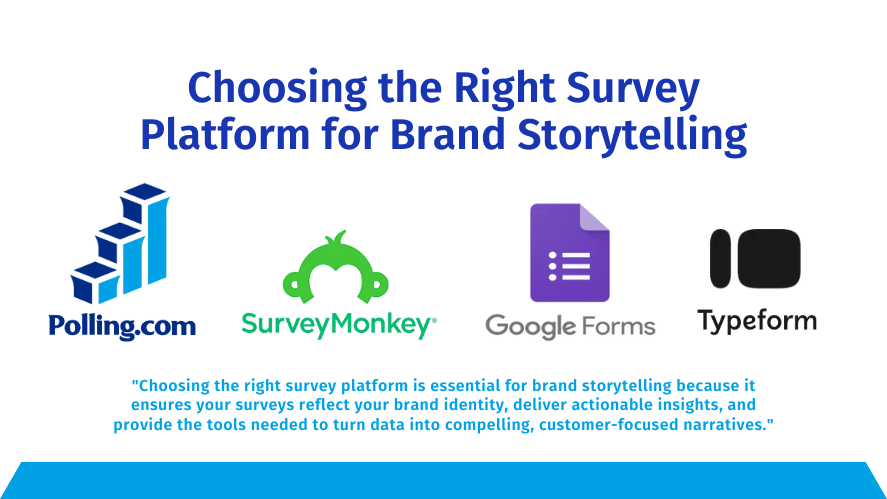
To create powerful branded stories, you need the right tools. Not all survey platforms offer the same level of customization or analytics. That’s why your choice matters.
Why Polling.com Stands Out for Branded Surveys
Polling.com was designed with brand storytelling in mind. It’s not just a survey builder it’s a strategic customer feedback management tool that helps you turn answers into stories.
Here’s what makes it stand out:
- Branding: Full design control, including themes, fonts, layouts, and tone.
- Analytics: Rich, real-time insights with easy filtering and segmentation.
- Support: Access to survey experts who help you build and refine your strategy.
- Content Tools: Built-in exports for reports, blogs, and visuals.
For marketers who care about brand image and storytelling, Polling.com is more than a product feedback tool it’s a complete system for customer insight and narrative development.
Quick Comparison Table: Polling.com vs. Competitors
| Feature | Polling.com | SurveyMonkey | Google Forms | Typeform |
|---|---|---|---|---|
| Branding Options | ✔ Full Customization | Limited | Minimal | Medium |
| Data Insights | ✔ Advanced | Medium | Basic | Medium |
| Support | ✔ Expert Guidance | Medium | Minimal | Low |
| Best For | Storytelling & Strategy | General Use | Simple Surveys | UX Surveys |
As the table shows, if you’re aiming to use survey and polling software for more than just simple questions if you want to tell a story Polling.com gives you the tools to do it right.
Use Cases Tailored for Brands
Here are some ways brands are using client survey software for better marketing:
- Product Launches: Get data before release to guide messaging and promotion.
- Customer Satisfaction Storytelling: Use NPS survey tool results to showcase how happy your customers are.
- Industry Thought Leadership: Publish insights on trends and behaviors in your market.
- Whitepapers and Reports: Combine survey findings with expert commentary to build credibility.
When your tools work with your brand, the results follow.
Best Practices for Leveraging Branded Surveys in Marketing
Collecting data is one step. Using it across channels is what really makes it shine.
Use Surveys as Content Generation Engines
One good branded survey can create:
- Blog Posts: Highlight trends, tips, or common pain points.
- Videos: Show reactions, summarize findings, or interview respondents.
- Webinars: Discuss results live with your team or guest experts.
- Infographics: Visualize key stats for easy sharing.
- Press Releases: Get media attention with a strong data angle.
With the right strategy, one survey leads to weeks of content. Polling.com helps automate this by offering free survey tools (with branding) and easy data export for content planning.
Make Your Data Visually Appealing
People understand stories better with visuals. A wall of numbers isn’t as memorable as a chart showing a surprising result.
For better impact, use graphs, bar charts, and quote blocks to bring your survey results presentation to life. Furthermore, color-code segments or highlight contrasting insights to drive home your points.
Polling.com offers built-in visualization tools that match your brand design, making it easier to stay on message.
Tell Stories Across Channels
Different platforms need different types of storytelling:
- LinkedIn: Focus on professional insights and trends.
- Instagram: Share polls, short stats, and customer quotes.
- YouTube: Create explainer videos or mini-documentaries.
- Email: Share sneak peeks or behind-the-scenes of your data collection.
Use your branding questionnaire findings to tailor messages by audience. One insight can be told five different ways, depending on the channel.
Maintain Ethical and Inclusive Practices
Last but not least, great surveys are honest and respectful.
To begin with, make sure your survey method is clear and your questions are fair. Additionally, avoid bias in how you ask and who you ask. Most importantly, let respondents know how their data will be used, and don’t twist findings to fit a narrative.
Follow this checklist:
- Provide a short intro explaining the survey’s goal
- Keep questions neutral and inclusive
- Use correct sampling methods
- Be transparent in sharing results
Remember, a good survey response rate starts with trust.
Ethical practices lead to stronger data, better engagement, and a reputation for honesty.
Conclusion
When it comes to building brand stories that connect, survey data is your secret weapon. It turns opinions into insight, and insight into narratives that feel real and persuasive.
With smart tools like Polling.com, you’re not just collecting answers you’re crafting campaigns, content, and messages that hit home. You’re building trust, guiding decisions, and standing out in a noisy market.
Whether you’re using customer feedback tools, launching a new product, or trying to boost your survey response rate, branded surveys give you the edge.
